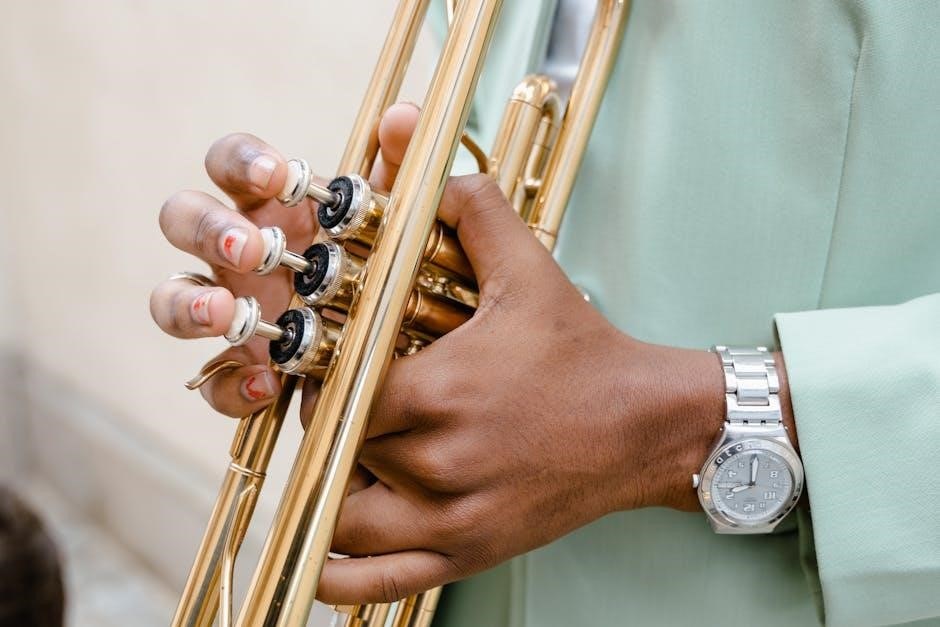Johann Nepomuk Hummel’s Trumpet Concerto in E-flat major is a cornerstone of trumpet repertoire, celebrated for its technical demands and lyrical melodies․ Composed in 1803, it remains a staple in classical music, offering both challenge and artistry for performers․ The concerto is often performed in E-flat major, simplifying fingering for modern trumpets․ Its duration of approximately 17 minutes showcases Hummel’s mastery of orchestration and soloist interaction․ The piece is widely available in PDF format, with arrangements for solo trumpet, piano, and string orchestra, making it accessible to musicians of various levels․
Overview of the Concerto
Johann Nepomuk Hummel’s Trumpet Concerto in E-flat major, composed in 1803, is a cornerstone of trumpet repertoire․ Known for its technical demands and lyrical passages, the concerto is a showcase for both the soloist’s artistry and orchestral accompaniment․ Its structure balances virtuosic demands with melodic elegance, making it a favorite among trumpeters․ The concerto is widely available in PDF format, with arrangements for solo trumpet, piano, and string orchestra, ensuring accessibility for musicians of various levels․ This concerto remains a significant work in classical music, highlighting Hummel’s mastery of orchestration and soloist-ensemble interaction․
Historical Background of Johann Nepomuk Hummel

Johann Nepomuk Hummel, born in 1778 in Pressburg (now Bratislava), was a renowned Austrian composer, pianist, and conductor․ A child prodigy, he studied under prominent figures like Mozart and Haydn, shaping his musical style․ Hummel’s career spanned the transition from the Classical to the Romantic era, influencing composers like Chopin and Liszt․ His Trumpet Concerto in E-flat major, composed in 1803, was written for the keyed trumpet, showcasing his innovative approach to instrumentation․ The concerto reflects Hummel’s mastery of orchestration and melodic writing, blending virtuosic demands with lyrical elegance․ It remains a cornerstone of trumpet repertoire, celebrated for its technical and artistic challenges․
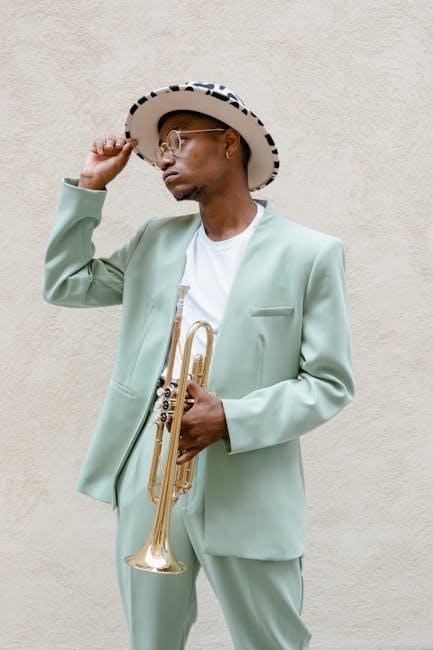
Structure and Movements of the Concerto
The Hummel Trumpet Concerto is structured in three movements: Allegro con Spirito, Andante, and Rondo ⏤ Allegro․ These movements showcase a balance of virtuosity and musicality, lasting approximately 17 minutes․
First Movement: Allegro con Spirito
The first movement of Hummel’s Trumpet Concerto, marked Allegro con Spirito, is a vibrant and dynamic opening that sets the tone for the entire work․ Scored in E-flat major, it features a lively dialogue between the solo trumpet and the orchestra, with intricate passages that highlight the soloist’s technical prowess․ The movement begins with a bold orchestral tutti, followed by the trumpet’s entrance with a thematic statement that combines lyricism and virtuosity․ The interplay between the soloist and the ensemble is a hallmark of this movement, with cadenzas that allow for improvisatory flair․ The music progresses through a series of developmental sections, culminating in a triumphant recapitulation․ This movement is a favorite among trumpet players, blending technical demands with musical elegance, making it a cornerstone of the trumpet repertoire․
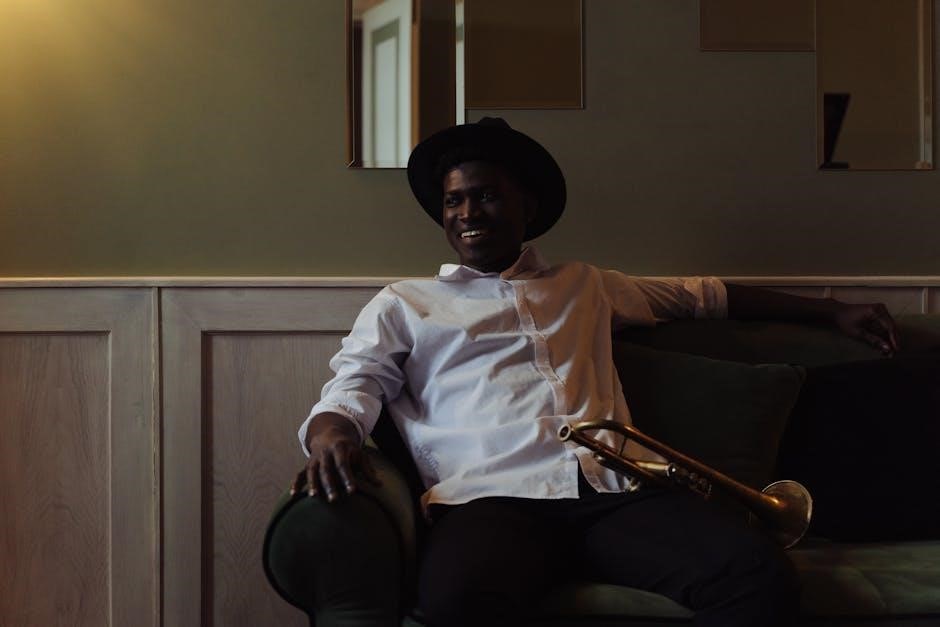
Second Movement: Andante
The second movement, Andante, offers a lyrical and reflective contrast to the spirited opening․ Scored in E-flat major, it features a beautiful, singing melody for the trumpet, accompanied by subtle orchestral textures․ The movement emphasizes expressive phrasing and nuanced dynamics, allowing the soloist to showcase lyrical playing․ The orchestra provides a supportive yet unobtrusive backdrop, with delicate interplay between the trumpet and the ensemble․ This movement is a favorite among trumpeters for its elegance and emotional depth, requiring precision and control to convey its serene and melancholic qualities․ The sheet music for this movement is widely available in PDF format, making it accessible for study and performance․ It remains a cornerstone of the trumpet repertoire, blending technical refinement with artistic expression․
Third Movement: Rondo ౼ Allegro
The third movement, Rondo ⏤ Allegro, is a lively and virtuosic finale that showcases the trumpet’s technical brilliance․ Characterized by its rondo form, the movement features a recurring main theme interspersed with contrasting episodes․ The soloist is challenged with rapid passages, intricate fingering, and dynamic contrasts, demanding both precision and stamina․ The orchestra provides a vibrant accompaniment, enhancing the movement’s energy and rhythmic drive․ This movement is a highlight of the concerto, demonstrating Hummel’s mastery of classical form and his ability to craft music that is both technically demanding and musically engaging․ The sheet music for this movement is widely available in PDF format, allowing trumpeters to study and perform this exhilarating conclusion to the concerto․
Arrangements and Transcriptions
Hummel’s Trumpet Concerto is available in various arrangements, including versions for trumpet and piano, string orchestra, and solo trumpet․ PDF sheet music is widely accessible online․
Version for Trumpet and Piano
The version for trumpet and piano offers an intimate rendition of Hummel’s concerto, preserving the original’s elegance while adapting it for a smaller ensemble․ This arrangement is ideal for practice and performance, allowing trumpeters to focus on the solo part without orchestral accompaniment․ The piano provides harmonic richness and rhythmic support, maintaining the piece’s dynamic contrasts․ PDF sheet music for this version is readily available online, making it accessible to students and professionals alike․ It is a popular choice for recitals and auditions, offering a refined yet demanding musical experience that highlights the trumpeter’s technical and expressive abilities․ This arrangement remains true to the original composition while offering a fresh perspective on Hummel’s masterpiece․
Version for Trumpet and String Orchestra
The version for trumpet and string orchestra is a popular arrangement of Hummel’s concerto, offering a unique blend of intimacy and grandeur․ This adaptation retains the original’s technical brilliance while emphasizing the interplay between the solo trumpet and the string ensemble․ The strings provide a lush harmonic foundation, allowing the trumpet to shine with clarity and expression․ PDF sheet music for this version is widely available, featuring the solo part in E-flat major, which is well-suited for modern trumpets․ This arrangement is particularly favored for its balanced texture and emotional depth, making it a staple in both concert performances and educational settings․ It captures the essence of Hummel’s original composition while presenting a distinct sonic experience․
Version for Solo Trumpet
The solo trumpet version of Hummel’s concerto is a technically demanding yet melodically rewarding piece for advanced players․ Available in PDF format, it often includes arrangements by notable artists like Michel Rondeau, enhancing its interpretive possibilities․ This version highlights the trumpet’s agility and expressiveness, with intricate passages that require precise articulation and control․ The solo part is frequently written in E-flat major, which suits modern trumpet fingering, though B-flat versions are also available․ PDF sheet music for the solo trumpet version can be downloaded from various platforms, offering both the full score and individual parts․ It remains a cornerstone of trumpet repertoire, challenging players to master its technical and musical demands while delivering a captivating performance experience․
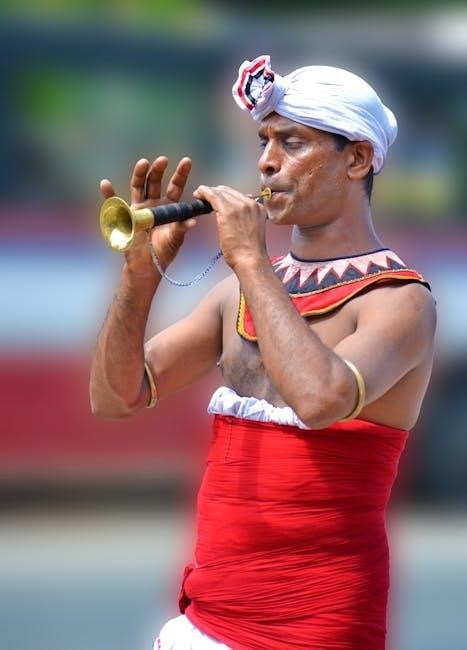
Performance Considerations
Hummel’s Trumpet Concerto demands technical precision and lyrical phrasing, with challenging passages requiring accurate articulation and breath control․ The E-flat and B-flat trumpet versions are commonly used, ensuring optimal playability and sound quality․
Trumpet Types: E-flat vs․ B-flat
The Hummel Trumpet Concerto is often performed in E-flat major, which is more commonly used for its ease of playability on modern trumpets․ The E-flat trumpet offers a brighter and more projecting sound, making it ideal for the concerto’s technical demands․ In contrast, the B-flat trumpet, while widely used, requires adjustments in fingering and embouchure due to its lower pitch․ Many performers prefer the E-flat version for its smoother transitions and clearer articulation, especially in the upper register․ Both versions are available in PDF sheet music, allowing musicians to choose based on their instrument and preference․ The choice between E-flat and B-flat ultimately impacts the overall timbre and performance quality of the concerto․
Challenges in Performing the Concerto
Performing the Hummel Trumpet Concerto presents several challenges, primarily due to its technical demands and musical complexity․ The concerto requires precise articulation, especially in the Allegro con Spirito movement, where rapid passages test the performer’s dexterity․ Additionally, the lyrical passages in the Andante movement demand a rich, expressive tone, necessitating careful control of dynamics and phrasing․ The Rondo-Allegro finale brings its own set of challenges with intricate rhythms and cadenzas, often requiring improvisation or mastering pre-composed cadenzas․ Proper breath control and endurance are essential due to the concerto’s 17-minute duration․ Musicians must also navigate the balance between the solo trumpet and orchestral accompaniment, ensuring clear projection and cohesive interpretation․ These elements make the concerto a true test of skill and artistry for trumpet players․
Orchestral Accompaniment Requirements
The Hummel Trumpet Concerto typically requires a classical orchestra or a reduced ensemble, often a string orchestra, to accompanies the solo trumpet․ The orchestration includes violins, violas, cellos, and double basses, providing a balanced and supportive harmonic foundation․ The interplay between the soloist and the orchestra demands precise coordination, particularly in dynamics and phrasing․ The availability of full scores and parts ensures that musicians can access the necessary materials for performance․ The concerto’s orchestral accompaniment is designed to enhance the solo trumpet’s melodies while maintaining a vibrant musical dialogue․ This setup allows for a clear projection of the trumpet’s voice, creating a cohesive and engaging musical experience․
Cadenza and Improvisation
The cadenza in Hummel’s Trumpet Concerto offers a moment for the soloist to shine with improvisation or pre-composed arrangements, such as Michel Rondeau’s notable cadenzas, blending technical brilliance and musicality․
Role of the Cadenza in the Concerto
The cadenza in Hummel’s Trumpet Concerto serves as a climactic showcase for the soloist, highlighting technical virtuosity and musical expression․ Typically placed near the concerto’s conclusion, it bridges the final orchestral tutti and the soloist’s closing dialogue․ This section allows the performer to demonstrate improvisational skills or perform pre-composed arrangements, such as those by Michel Rondeau․ The cadenza adds a personal touch, enabling the trumpeter to interpret the music uniquely while maintaining the concerto’s structural integrity․ It is a moment of brilliance, blending dazzling technique with artistic sensitivity, and remains a defining element of the concerto’s charm and appeal for both performers and audiences․ The cadenza’s role is pivotal, elevating the soloist’s presence and deepening the musical experience․
Notable Cadenza Arrangements by Michel Rondeau
Michel Rondeau’s cadenza arrangements for Hummel’s Trumpet Concerto are renowned for their innovative and technically challenging approach․ His transcriptions blend seamlessly with the concerto’s thematic material, offering a fresh yet respectful interpretation․ Rondeau’s arrangements are celebrated for their virtuosic demands, pushing the boundaries of trumpet technique while maintaining musicality․ They are widely performed and admired, providing a modern perspective on Hummel’s classic work․ These arrangements are available in PDF format, making them accessible to trumpeters seeking to enhance their performance with a contemporary edge․ Rondeau’s contributions have significantly enriched the concerto’s interpretative landscape, ensuring its continued relevance in modern trumpet repertoire․
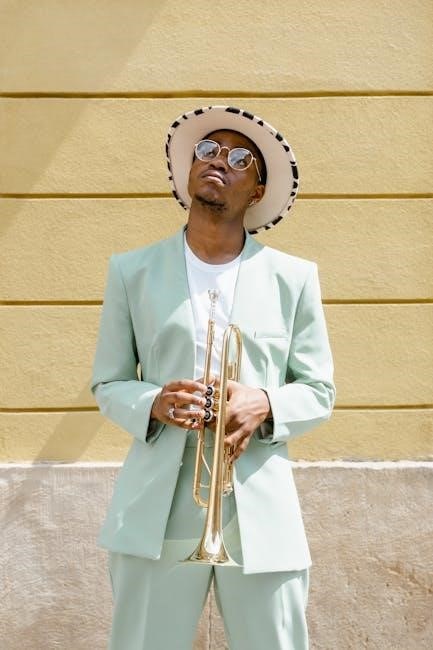
Orchestration and Instrumentation
Hummel’s Trumpet Concerto features a solo trumpet accompanied by a full orchestra or smaller ensembles like string orchestra or piano reductions, showcasing rich harmonic textures and balance․
Full Score and Parts Availability
The full score and parts for Hummel’s Trumpet Concerto in E-flat are widely available in PDF and MIDI formats․ Complete scores, including arrangements by Michel Rondeau, can be downloaded for free or purchased․ The concerto is often provided with detailed instrumentation, including solo trumpet parts in both E-flat and B-flat versions․ Many platforms offer full scores, with some sources offering over 10 pages of sheet music․ Additionally, parts for string orchestra and piano reductions are accessible, catering to different performance settings․ These resources are easily accessible online, making it convenient for musicians to obtain and perform the concerto․ Availability ensures that both professionals and enthusiasts can engage with this timeless piece․

Instrumentation for Solo and Ensemble
Hummel’s Trumpet Concerto in E-flat major features a solo trumpet part, often available in both E-flat and B-flat versions to accommodate modern instruments․ The ensemble typically includes a full orchestra, with strings, woodwinds, and brass sections․ Some arrangements also include reductions for piano or string orchestra, making the piece adaptable to smaller ensembles․ The solo trumpet part is technically demanding, requiring precision and lyrical expression․ The interplay between the soloist and orchestra highlights Hummel’s mastery of classical orchestration․ The instrumentation is well-suited for both professional orchestras and chamber groups, ensuring the concerto remains accessible and friendly․ This versatility has contributed to its enduring popularity in classical trumpet repertoire․

Downloading and Accessing the Sheet Music

The Hummel Trumpet Concerto in E-flat is widely available as PDF sheet music for solo trumpet, piano, and string orchestra․ Download options include free and paid versions․
PDF Resources for Trumpet Concerto in E-flat
The Hummel Trumpet Concerto in E-flat is readily available in PDF format, offering convenient access for musicians․ Platforms like MuseScore and SheetMusicPlus provide free and paid versions, catering to various preferences․ The concerto is often presented in arrangements for solo trumpet, piano accompaniment, or string orchestra, ensuring versatility for different performance settings․ Many resources include detailed fingerings for both E-flat and B-flat trumpets, addressing the needs of modern instrumentalists․ Additionally, some editions feature cadenzas by notable arrangers like Michel Rondeau, enhancing the piece’s interpretative possibilities․ With its composition in 1803, the concerto remains a beloved classic, and its PDF availability ensures its continued accessibility and popularity among trumpet enthusiasts․
Free Sheet Music Platforms and Websites
Several platforms offer free sheet music for the Hummel Trumpet Concerto in E-flat, making it accessible to musicians worldwide․ Websites like MuseScore and SheetMusicPlus provide downloadable PDF versions, often with arrangements for solo trumpet, piano accompaniment, or string orchestra․ These platforms cater to diverse performance needs, ensuring that both professionals and students can access the concerto․ Many free resources include detailed fingerings for E-flat and B-flat trumpets, facilitating ease of play․ Additionally, some sites offer optional cadenzas and interpretative notes, enriching the performance experience․ This widespread availability underscores the concerto’s enduring popularity and ensures its continued relevance in classical trumpet repertoire․

Johann Nepomuk Hummel’s Trumpet Concerto in E-flat major remains a timeless masterpiece, blending technical brilliance with lyrical beauty․ Its availability in PDF ensures accessibility for modern musicians, preserving its legacy․
Final Thoughts on the Hummel Trumpet Concerto
Johann Nepomuk Hummel’s Trumpet Concerto in E-flat major stands as a testament to classical music’s enduring elegance․ Its blend of technical brilliance and melodic grace continues to captivate audiences and inspire musicians․ The concerto’s accessibility in PDF format has made it a favorite among trumpet enthusiasts, allowing for widespread study and performance․ Whether played by a soloist with an orchestra or in simplified arrangements, the piece retains its emotional depth and virtuosic charm․ As a cornerstone of trumpet repertoire, Hummel’s concerto remains a celebration of musical artistry, offering both challenge and joy for performers and listeners alike․ Its legacy endures, ensuring its place in the hearts of classical music lovers for generations to come․
